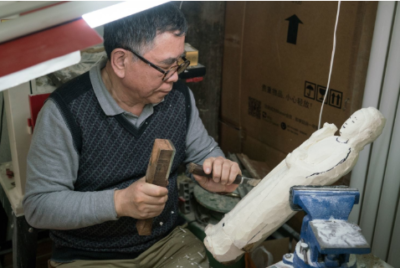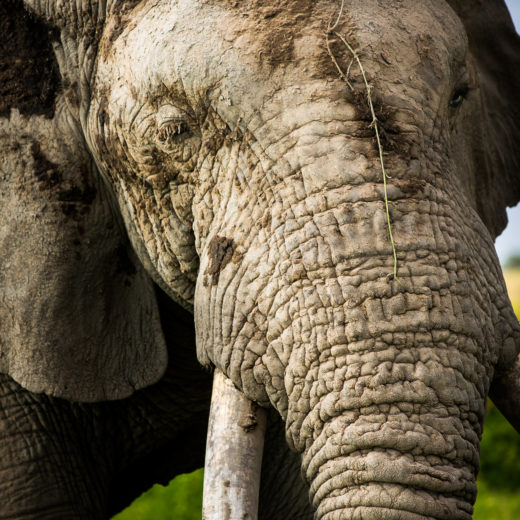


By: Simon Denyer
Li Chunke began carving ivory after leaving school as a 15-year-old boy.
Today, at 68, this master craftsman is working until the early hours of every morning, trying to finish a 20-inch statuette of Buddha on an unforgiving deadline — before China implements a total ban on ivory sales at the end of this month. The art of ivory carving survived even the tumult of China’s Cultural Revolution, but he’s worried it may soon die out.
“What makes China great is that its traditional culture still exists,” he said. “If it disappears in China, it will be a loss for the whole world.”
Yet China’s commitment to put craftsmen like Li out of business and close down its ivory industry has thrown a lifeline to African elephants and brought new hope in the battle to end the poaching of tens of thousands of animals every year for their tusks.
The Chinese government shut down 67 ivory-carving workshops and retail outlets in March, and will have closed the remaining 105 by the end of this year, honoring a commitment President Xi Jinping first made alongside President Barack Obama in 2015.
“China’s ban is one of the most important things that has happened to elephants in the last 10 years,” said Iain Douglas-Hamilton, one of the world’s leading elephant conservationists and founder of Save the Elephants.
“It’s a highly significant step, and I think the impact is increasingly being felt in parts of Africa. But although the net is tightening, the battle is not won at all,” he said.
Poaching levels have dropped slightly in each of the past five years, according to research for the Convention on International Trade in Endangered Species (CITES), and stronger law enforcement efforts have pushed ivory seizures to a record high. But the total number of elephants in Africa is still thought to be declining because of illegal killings.
However, the looming prospect of China’s ban appears to have pricked the speculative bubble that had contributed to the poaching crisis. The wholesale price of raw ivory in China is reported to have fallen by almost two-thirds in the past three years, from $2,100 per kilogram in 2014 to $730 in February 2017.
China had been the world’s biggest ivory market. Until this year, craftsmen were legally allowed to work with ivory from a stockpile imported in 2008 — but that business provided cover for a vast illegal trade.
Rising wealth, a growing appreciation of ivory as part of Chinese cultural heritage, its value as a status symbol and popular gift, a sense that it was an inflation-proof investment, and its use in Buddhist beads, pendants or figurines had all combined to create a boom in the industry, experts say — and a huge opportunity for global crime syndicates to exploit.
At the peak of the ivory boom, from 2010 to 2012, more than 30,000 elephants were slaughtered every year, research showed.
But the global conservation movement fought back: Instead of pointing fingers, advocates made China feel part of a joint effort to end the trade, involving source countries, transit countries and destination countries, said John Scanlon, secretary general of CITES.
It helped that Xi wanted to curb corruption. Ivory was a popular gift to woo an official or grease a business deal. Poaching was also damaging China’s image in Africa, where it has been investing and gaining influence.
Within China, a public awareness campaign was crafted by the San Francisco-based group WildAid, backed by state media and fronted by former National Basketball Association player Yao Ming and other Chinese celebrities. Most Chinese people had not been aware before then that elephants had to die for their ivory to be harvested.


Former NBA star Yao Ming attends a WildAid media event for an ivory-reduction campaign in Shanghai in 2013. (Eugene Hoshiko/AP)
With a total ban in place, the job for law enforcement will be much easier: Any sales of elephant ivory anywhere in China will soon be illegal.
Yet the battle to win over the Chinese consumer is far from over.
A survey released Wednesday by two affiliated wildlife organizations, TRAFFIC and the World Wildlife Fund, found that less than half of consumers surveyed recalled having heard of the ivory ban. After being told of the ban, most people said they would support it, and many said they had already stopped buying ivory. But the survey found a “die-hard” 19 percent of consumers who were inclined to keep buying ivory, even after it is banned.
In Beijing, shopkeepers are offering heavy discounts to shift stock before the ax falls. An intricately carved tusk in one outlet was recently reduced from nearly $1 million to around $600,000, and other items were offered with similar discounts.
But just outside China’s borders, ivory is still openly on sale and is still being eagerly snapped up by some Chinese consumers.
A study by Save the Elephants released in September found that Laos was the fastest-growing ivory market in the world, with Chinese tourists buying up 80 percent of the ivory on sale there at prices significantly lower than in China.
Vietnam is another big market, with ivory openly on sale and smugglers crossing back and forth across the border to supply Chinese consumers, said Zhou Fei, head of the China wildlife programs for TRAFFIC. The Golden Triangle, a lawless opium-producing region straddling Burma, Thailand and Laos, is another region where Chinese-run businesses supply Chinese consumers with African ivory, experts say.
Cambodia has become another transit point for the illegal trade. Earlier this month, officials there seized nearly 1.1 tons of ivory hidden in hollowed-out logs.


Cambodian authorities show pieces of ivory seized in Preah Sihanouk province on Dec. 5. (Suon Vin/AFP/Getty Images)
“When you tighten the screws in one place, criminal groups will target another place,” Scanlon said. “The last thing we want to do is let the pressure off and think we’ve won yet.”
Peter Knights, chief executive at WildAid, applauds China’s leadership, but he laments that “Britain is dragging its feet” and that Japan is the only major consumer still unwilling to join the global effort.
Under Obama, the United States tightened federal laws to ban cross-border and interstate trade; seven states have enacted their own intrastate bans.
“China took the first step, and it needs to feel that other countries are supporting it and also stepping up to the plate,” said Grace Ge Gabriel, Asia director for the International Fund for Animal Welfare.
In November, the U.S. Fish and Wildlife Authority set alarm bells ringing in the conservation community by announcing it would reverse a ban on trophy-hunting imports from Zimbabwe and Zambia. Two days later, Trump tweeted that elephant hunting is a “horror show” and put the move on hold.
“There were leaders on the Republican side in Congress and Fox News hosts pleading with him not to allow elephant trophy hunting,” said Iris Ho, wildlife program manager for the Humane Society International in Washington. “On the elephant protection issue, there is strong bipartisan support, especially on the Republican side.”
Yet, despite the global concerns, Knights and Ho say China is unlikely to waver.
“Don’t forget, this ban came from the top,” Knights said. “Once these things happen, they don’t tend to get reversed. China sees this as a matter of pride.”
Ivory carving in China traces its origins to the Ming and Qing dynasties, from the 14th to the early 20th centuries, when the craft’s main consumers came from the imperial court and elite scholar-officials.


Ivory dust flies as Zhang Yong works on a carving at Li Chunke’s ivory-carving workshop Dec. 10. (Yan Cong/For The Washington Post)




It was revived after the communist takeover in 1949 but soon ran into trouble. Master carver Li remembers well the chaos of the Cultural Revolution, a decade of upheaval unleashed by Mao Zedong in 1966, when Red Guards mounted frenzied attacks against the Four Olds — old ideas, customs, culture and habits — and destroyed books and art and ransacked museums and temples.
At first, Li said, ivory carvers were banned from traditional subjects and had to focus instead on “modern” art, including scenes from revolutionary ballets like “The Red Detachment of Women.”


An unfinished ivory statue of Taoist goddess Magu, who represents longevity. Pan Xingjie has spent about a month working on this statue at Li Chunke’s workshop. (Yan Cong/For The Washington Post)
But revolutionary art didn’t sell, and Mao’s government needed foreign currency. By 1968, Li and his fellow carvers were ordered to return to more traditional subjects, carving pieces that would be sold abroad to earn foreign exchange.
“Outside, they were destroying the Four Olds. Inside, we were creating the Four Olds,” he said.
Today, he loves carving people and conveying emotion in his figures, as well as creating impossibly intricate images of flowers, birds, mountains and rivers. Every piece of ivory he carved, he insists, came from approved and certified sources, and never from poachers.
Stay in touch and get the latest WildAid updates.
SIGN UPAbout WildAid
WildAid is a non-profit organization with a mission to protect wildlife from illegal trade and other imminent threats. While most wildlife conservation groups focus on protecting animals from poaching, WildAid primarily works to reduce global consumption of wildlife products such as elephant ivory, rhino horn and shark fin soup. With an unrivaled portfolio of celebrity ambassadors and a global network of media partners, WildAid leverages more than $308 million in annual pro-bono media support with a simple message: When the Buying Stops, the Killing Can Too.
Journalists on deadline may email communications@wildaid.org


